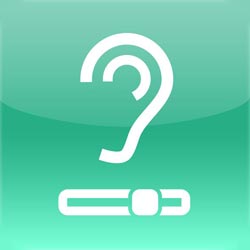iPhone app offers individual hearing support

The app AuditoryVoIP is available initially for the iPhone<br>Fraunhofer IDMT <br>
Transmission losses and background noise can considerably impair speech intelligibility when making calls on a cell phone – particularly for people who suffer from hearing loss. Hearing research scientists have now developed an app for the iPhone that improves speech intelligibility for internet phone calls made using Voice over IP technology.
In addition to allowing adjustment of loudness and sound settings to meet individual preferences, the app is also able to compensate for hearing loss. The technology was developed by the Oldenburg Project Group for Hearing, Speech and Audio Technology at the Fraunhofer Institute for Digital Media Technology IDMT.
Individual sound adjustment without a hearing test
In addition to the standard functions of a softphone, the new app »AuditoryVoIP« offers hearing support that can be individually adjusted by the user. A hearing test is not necessary for this. Using a simple user interface, users can choose their preferred sound quality and volume from various default settings. An intelligent signal processing module then optimizes all incoming calls to match this hearing profile. Speech signals that were previously perceived as being too loud, booming, muffled or shrill are reproduced as a uniform sound pattern with improved speech intelligibility. Initial studies show that this allows people with slight to moderate hearing loss to again easily understand telephone conversations.
»The new feature of our technology is that the telephone signal is not optimized to a standard technical value, but to the user’s personal hearing preferences. With our solution, it does not matter whether a person with normal hearing has certain sound preferences or whether the user suffers from a medically diagnosed hearing impairment,« explains Jan Rennies from the Project Group Hearing, Speech and Audio Technology. »However, AuditoryVoIP does not have the functional scope of a hearing aid. The technology is specifically optimized for the frequency range of a telephone signal.«
Around 50 million people with untreated hearing loss in Europe
The transition from normal hearing to hearing impairment is seamless. Natural hearing ability already starts to deteriorate from the age of fifty onwards. In Europe, around 50 million people with impaired hearing do not use a hearing aid. In order to address the needs of this group, the Fraunhofer Project Group Hearing, Speech and Audio Technology works on developing ways of integrating personalized hearing support in electronic telecommunications and entertainment devices.
»Poor speech intelligibility usually has to be compensated by higher concentration. This mental strain can lead to fatigue and reduced performance at work,« says Professor Birger Kollmeier, head of the project group and spokesperson for cluster of excellence »Hearing4all« at the University of Oldenburg, explaining the motivation for development of the technology. »It is also important that the sense of hearing remains in active use – like with muscles. If the sense of hearing is not stimulated, its ability to function properly decreases. If a person does not use hearing assistance technology for too long when hearing loss starts, they will find it much more difficult later on to get accustomed to and benefit from a hearing aid.«
AuditoryVoIP is marketed by Hörtech gGmbH as a product of the »AuditoryValley« research and development network and is available initially for the iPhone. A paid access account with an internet telephony provider is required in order to use the app.
About the Project Group Hearing, Speech and Audio Technology of the Fraunhofer Institute for Digital Media Technology IDMT
The goal of the Project Group for Hearing, Speech and Audio Technology of the Fraunhofer IDMT is to implement scientific findings on auditory perception of normal and impaired hearing in technological applications. Scientists carry out applied research and development on behalf of industrial companies and public institutions in the fields of telecommunications, multimedia, health and care services, building technology, transport, industrial production and security. The project group was established in Oldenburg in 2008 as a branch of the Fraunhofer Institute for Digital Media Technology IDMT. Through scientific cooperations, it has close links with the hearing research facilities in Oldenburg and is also partner in the cluster of excellence »Hearing4all«.
About Auditory Valley
In the Auditory Valley research and development network, around 250 hearing research scientists at the facilities in Oldenburg and Hanover collaborate with leading international manufacturers of hearing aid, cochlear implant and audio system technology. The goal is to significantly improve the hearing ability of persons with normal and impaired hearing through implementation of current scientific findings in product development and patient treatment. The scientific network partners who have received research funding in the cluster of excellence »Hearing4all« since 2012 include the University of Oldenburg, the Leibniz University of Hannover and the Hannover Medical School as well as the German Hearing Center Hannover, Fraunhofer IDMT, HörTech gGmbH, Hörzentrum Oldenburg GmbH, and the Jade University of Applied Sciences Wilhelmshaven/Oldenburg/Elsfleth.
Weitere Informationen:
http://www.auditory-voip-com
http://www.idmt.fraunhofer.de
http://www.auditory-valley.com
Media Contact
More Information:
http://www.idmt.fraunhofer.deAll latest news from the category: Information Technology
Here you can find a summary of innovations in the fields of information and data processing and up-to-date developments on IT equipment and hardware.
This area covers topics such as IT services, IT architectures, IT management and telecommunications.
Newest articles

Combatting disruptive ‘noise’ in quantum communication
In a significant milestone for quantum communication technology, an experiment has demonstrated how networks can be leveraged to combat disruptive ‘noise’ in quantum communications. The international effort led by researchers…

Stretchable quantum dot display
Intrinsically stretchable quantum dot-based light-emitting diodes achieved record-breaking performance. A team of South Korean scientists led by Professor KIM Dae-Hyeong of the Center for Nanoparticle Research within the Institute for…

Internet can achieve quantum speed with light saved as sound
Researchers at the University of Copenhagen’s Niels Bohr Institute have developed a new way to create quantum memory: A small drum can store data sent with light in its sonic…





















